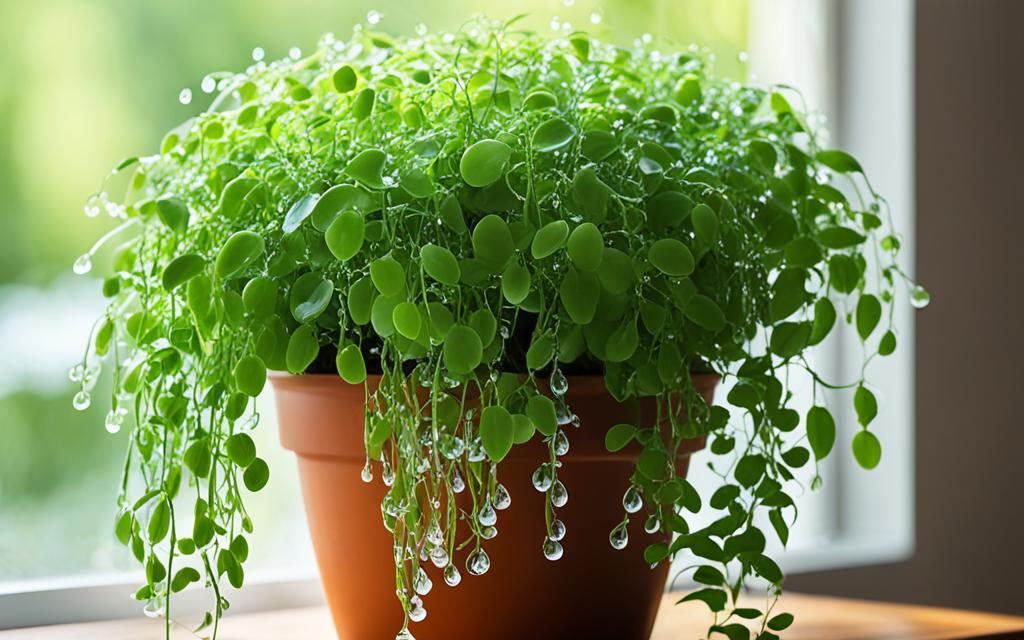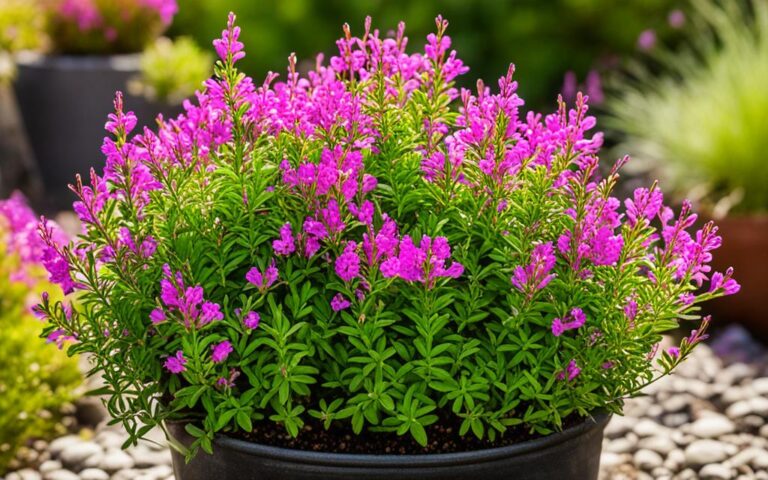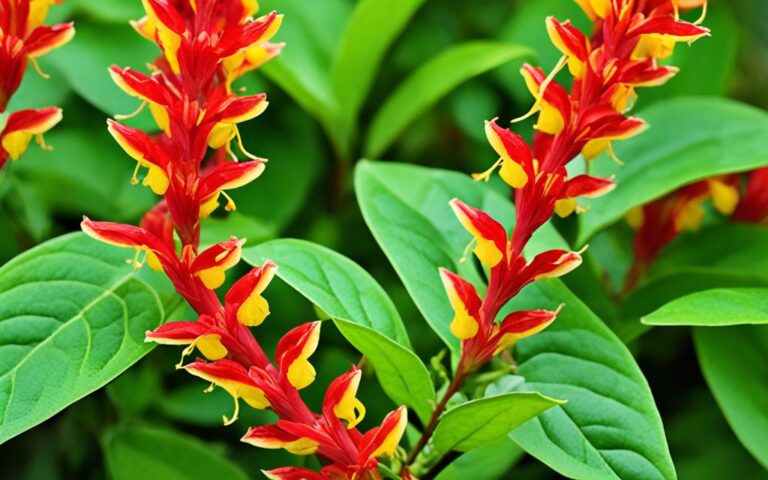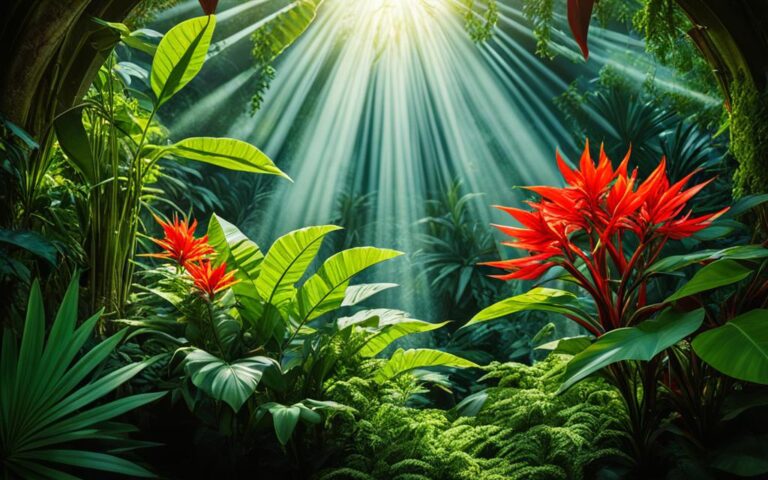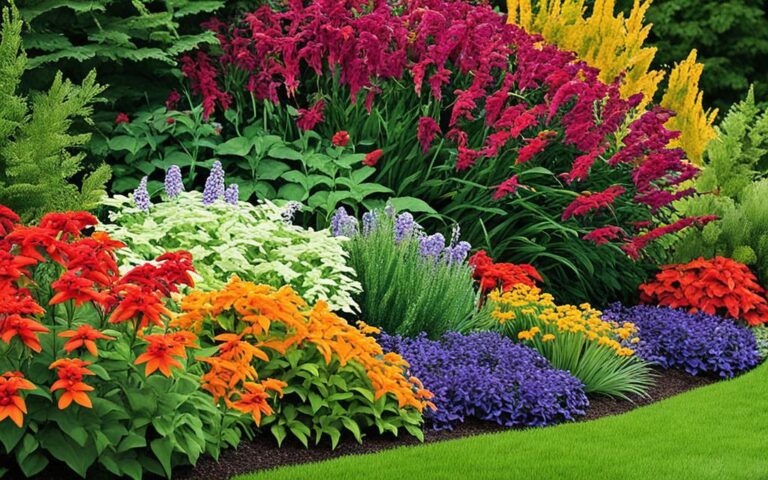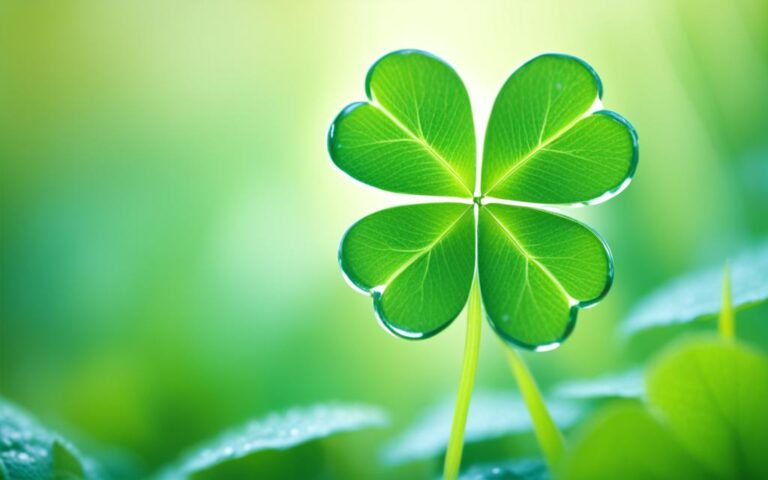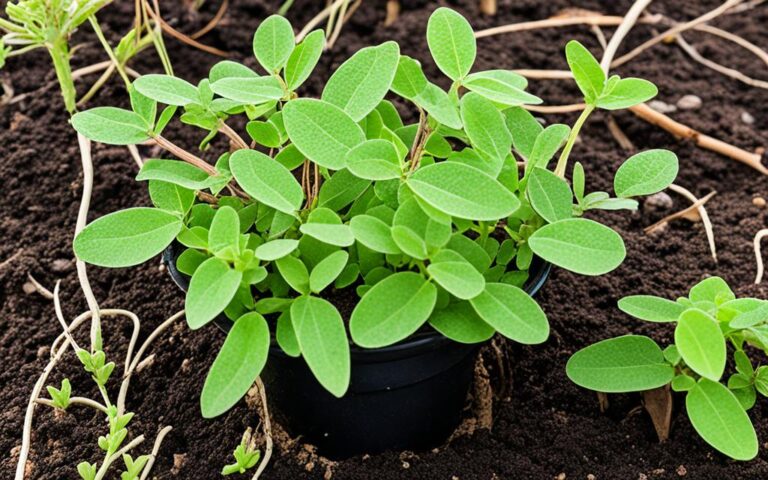Baby Tears Plant: Care Tips for Delicate Greenery
Did you know the Baby’s Tears plant (Soleirolia soleirolii) can grow up to 36 inches wide? It looks delicate but can spread a lot. This tropical plant is perfect for terrariums and low-light spots. With proper care, it can cover the ground beautifully.
Key Takeaways
- Baby’s Tears plant belongs to the Urticaceae family and is often mistaken for a type of moss.
- These plants can grow up to 4 inches tall and 36 inches wide, creating a dense, delicate mat of fine, round or bean-shaped leaves.
- Baby’s Tears plants thrive in warm, humid environments and prefer partial shade to bright indirect light.
- Regular misting, fertilization, and pruning are essential to maintain the lush, healthy appearance of Baby’s Tears plants.
- These plants are easy to propagate through division and stem cuttings, making them a great choice for beginner gardeners.
Introduction to Baby Tears Plant
The baby tears plant, known as Soleirolia soleirolii, is a beautiful part of the Urticaceae family. It grows low and spreads out, forming a mat. It comes from the western Mediterranean islands of Corsica and Sardinia. It’s also called “angel’s tears,” “Corsican Carpet Plant,” “Irish Moss,” and “Mind Your Own Business Plant.”
Common Names and Botanical Designation
This plant is also known as baby’s tears, angel’s tears, Corsican Carpet Plant, Irish Moss, and Mind Your Own Business Plant. Its scientific name is Soleirolia soleirolii. It’s in the Urticaceae family, which includes nettles and similar plants.
Origins and Family
Soleirolia soleirolii, the baby tears plant, comes from the western Mediterranean islands of Corsica and Sardinia. It’s in the Urticaceae family. This family has small, delicate leaves and plants that spread out.
“The baby tears plant is a delicate, charming addition to any indoor or outdoor space, offering a lush, carpet-like groundcover that adds a touch of whimsy to any garden or container.”
Varieties of Baby Tears Plant
The Baby Tears plant, known as Soleirolia soleirolii, has many varieties that are visually stunning. Each variety has its own unique look.
Soleirolia soleirolii ‘Aurea’
Soleirolia soleirolii ‘Aurea’ stands out with golden foliage. It’s a bit shorter than other types and doesn’t spread much. It loves dappled shade to grow well.
Soleirolia soleirolii ‘Golden Queen’
Soleirolia soleirolii ‘Golden Queen’ has yellowish leaf margins. These edges make a beautiful contrast with the green leaf centers. This variety brings a pop of color to any spot.
Soleirolia soleirolii ‘Argentea’ or ‘Silver Queen’
Soleirolia soleirolii ‘Argentea’ or Soleirolia soleirolii ‘Silver Queen’ offers silver-gray foliage. It’s perfect for creating a calm, elegant look. It blends well with other plants, making a peaceful setting.
| Variety | Foliage Color | Growth Habit | Light Preference |
|---|---|---|---|
| Soleirolia soleirolii ‘Aurea’ | Golden | Compact, Slower Spreading | Dappled Shade |
| Soleirolia soleirolii ‘Golden Queen’ | Yellowish Leaf Margins | Trailing, Spreading | Bright, Indirect Light |
| Soleirolia soleirolii ‘Argentea’ or ‘Silver Queen’ | Silver-Gray | Trailing, Spreading | Bright, Indirect Light |
Understanding the Plant’s Anatomy
Leaves, Stems, and Flowers
The baby’s tears plant (Soleirolia soleirolii) has tiny, round leaves on short stems. These leaves look like moss and spread out, forming a lush carpet. It also has small, creamy white flowers that add beauty to its look.
Unique Characteristics and Features
The baby’s tears plant stands out with its fine-textured leaves that form a moss-like mat. Its stems trail and creep, helping it spread and cover large areas. This makes it perfect for ground cover, cascading over containers, or filling garden gaps.
“The baby’s tears plant’s dense, delicate mat of fine leaves gives it a truly enchanting, moss-like appearance that sets it apart from other houseplants.”
| Characteristic | Description |
|---|---|
| Leaf Shape | Tiny, round or bean-shaped |
| Leaf Texture | Delicate, fine-textured |
| Stem Structure | Short, fleshy |
| Flower Size | Less than 1 inch |
| Flower Color | Creamy white |
| Growth Habit | Mat-forming, trailing, creeping |
| Appearance | Moss-like |
Ideal Growing Conditions
Baby tears plants do best in partial sun to shade. They like to stay away from direct sunlight to prevent damage. Indoors, they can also do well under artificial lights if they get enough light.
The best temperature for these plants is between 60°F and 65°F during the day. At night, they like it to be between 50°F and 55°F. They need a lot of humidity, around 60-75%, to stay green and healthy.
Light Requirements
Place baby tears plants about 6 feet away from a south-facing window for the right amount of light. It’s important to keep them away from direct sunlight. This can cause their leaves to burn and slow their growth.
Temperature and Humidity Needs
Baby tears plants grow best in cool temperatures, from 60°F to 65°F in the day and 50°F to 55°F at night. They also need a lot of humidity, 60-75%, to stay healthy and moist.
Soil Composition and pH Levels
These plants like a rich, well-draining soil mixed with humus, compost, or manure. The soil should be slightly acidic, with a pH between 5.0 and 6.0. This supports their growth and keeps their leaves colorful.
Watering Frequency
Keep the soil of baby tears plants consistently moist but not waterlogged. Water them every 5-7 days when they’re growing. Be careful not to overwater, as this can cause root rot and other problems.
By giving your baby tears plant the right light, temperature, humidity, soil, and water, you can help it thrive. This will make your plant healthy and beautiful.
baby tears plant Propagation Methods
Baby’s tears plants, known as Soleirolia soleirolii, can be easily spread through division and stem cuttings. These methods help gardeners grow more plants and share them with friends.
Division
Division means taking a part of the plant with roots, stems, and soil and replanting it. Do this in the spring or early summer when the plant is growing well. To divide a baby’s tears plant, lift the whole plant from the soil. Then, use a sharp, clean knife or scissors to cut through the roots, making two or more new plants.
Each new plant should have its own roots and stems. Put the new plants in well-draining soil and keep the soil moist until they grow new leaves, which happens quickly.
Stem Cuttings
Using stem cuttings is another good way to spread baby’s tears. Cut 2-inch pieces from healthy stems just below a leaf node. Then, take off the lower leaves.
Dip the cut end in rooting powder or gel to help roots grow. Plant the cuttings in moist, well-draining soil. Keep the soil wet, and you should see new growth in a month. Cuttings in water can start showing roots in 2-3 weeks.
It’s key to give the new plants the right conditions, like bright, indirect light, consistent moisture, and warm temperatures. With proper care, both cuttings and divisions of baby’s tears can flourish, adding to your garden.
Care and Maintenance Essentials
The baby tears plant (Soleirolia soleirolii) needs gentle care. Pruning is optional but helps keep it tidy, especially in small spaces. Cutting stems and leaves encourages new growth and makes the plant look fuller.
Pruning and Training Techniques
Use sharp, clean shears for pruning baby tears plants. Don’t tear or crush the stems. Prune a little often to help the plant heal fast and stay healthy.
Pest and Disease Management
Baby tears plants can get pests like aphids, whiteflies, and scale insects. They might also get root rot if the soil is too wet. Use insecticidal soap or neem oil for pests and fix watering issues to prevent diseases.
Fertilization Requirements
Give baby tears plants a balanced, water-soluble liquid fertilizer every two weeks in spring and summer. Don’t fertilize in fall and winter when they grow less.
“Proper care and maintenance are key to keeping baby tears plants thriving and within bounds.”
Repotting and Transplanting
As your Baby Tears plant grows, it will need a bigger home. It’s important to pick a pot that’s about 2 inches larger in diameter than the old one. Terracotta pots are good because they let air in, which is good for the roots. But, they can break if you drop them.
When you’re repotting, make sure the soil drains well. A mix of perlite, peat moss, and vermiculite in equal parts works great. This mix helps your Baby Tears plant grow well.
Baby Tears plants grow fast, so you should repot every 2 years. To move your plant, carefully take it out of its pot without hurting the roots. Put it in a new pot that’s a bit bigger, and fill in the sides with fresh soil. Water it well and watch it settle in its new spot.
When watering, check the soil by sticking your finger in it. Water when the top 2-4 inches (5-10 cm) of soil feels dry. You can use fertilizers to feed your plant, but don’t give it too much. Too much fertilizer can hurt your plant.
By dividing and transplanting your Baby Tears plant often, you help it keep growing and spreading its beauty around your home or garden.
Benefits of Growing Baby Tears Plant
The Baby Tears plant, known as Soleirolia soleirolii, is great for indoor or outdoor gardens. It’s a groundcover, terrarium plant, and edging plant that adds beauty and function to your spaces.
This plant is amazing because it cleans the air. Its small, kidney-shaped leaves take in toxins like formaldehyde and turn carbon dioxide into oxygen. This makes the air cleaner, which can help you think better and feel less stressed.
The Baby Tears plant also makes any room or garden look calm and beautiful. Its lush, trailing leaves add elegance and create a peaceful feel. It symbolizes growth, adaptability, and connection, adding to its charm.
Looking after Baby Tears plants is easy, even for beginners. With the right care, they can make your spaces look amazing. Famous plant expert Larry Hodgson grows over 3,000 types of plants, including Baby Tears.
In summary, the Baby Tears plant has many benefits. It purifies the air and adds beauty to any space. Whether as a groundcover, terrarium plant, or edging plant, it makes your living area healthier and more beautiful.
Container Gardening with Baby Tears
Baby’s tears plants, also known as Soleirolia soleirolii, are perfect for container gardens. They have a cascading habit and small, delicate leaves. These plants do well in hanging baskets, mixed planters, and terrariums, adding beauty and lushness.
For container gardening, baby’s tears need well-drained soil that stays moist. They like partial shade to shade, making them great for indoor spots or places with little light. A balanced, water-soluble fertilizer helps them grow healthy and keeps their leaves green.
- Hanging baskets: Baby’s tears plants are great for hanging baskets, where they can cascade beautifully.
- Mixed planters: Mix them with other plants like succulents or ferns for interesting and textured container gardens.
- Terrariums: Terrariums offer the perfect humidity and light for baby’s tears, creating a charming miniature garden.
When gardening with baby’s tears, keep the soil moist and provide the right light for them to flourish. With the right care, these plants can bring lush, green beauty to any indoor or outdoor area.
“Baby’s tears are a wonderful choice for container gardening, adding a soft, cascading element to any setup. Their low-maintenance nature and adaptability to different light conditions make them a versatile option for both indoor and outdoor spaces.”
Adding baby’s tears to your container gardening, whether in hanging baskets, mixed planters, or terrariums, can be both fun and rewarding.
Outdoor Planting and Hardy Zones
Baby’s tears plants, also known as Soleirolia soleirolii, are perfect for outdoor growth in subtropical and temperate climates. They thrive in USDA zones 9 to 11 but can’t handle frost well. In colder areas, they should be kept indoors or grown as houseplants to avoid frost damage.
When planting outdoors, make sure to give these plants shade or partial shade. The soil should always be damp to moist, as they like it that way. In temperate climates, they can even survive freezing temperatures, turning black briefly before recovering.
But, they can get out of control in some places in the U.S. Regular shovel pruning helps keep them in check. Indoors, they do well in bright, indirect light and damp to moist soil. This makes them great for open terrariums.
| Characteristic | Value |
|---|---|
| Hardiness | USDA Zones 7 – 15 |
| Heat Tolerance | USDA Zones 10 – 12 |
| Typical Height | 1″ to 2″ |
| Typical Spread | 6″ to 12″ |
| Pot Size | 4″ Pot |
The baby’s tears plant has trailing stems that can spill over the pot’s edges. This creates a beautiful, cascading look. With the right care, this plant can flourish both indoors and outdoors in the right subtropical and temperate USDA zones 9-11.
Troubleshooting Common Issues
The baby tears plant can face challenges, just like any houseplant. Knowing how to fix these problems can help your plant stay beautiful and lush.
Wilting and Drying Out
Wilting often means the plant is underwatered. Baby tears plants dry out easily if they’re in small pots. Make sure the soil is always moist but not too wet. Wait until the top inch of soil feels dry before you water again.
Overwatering and Root Rot
Too much water can cause root rot in baby tears plants. This happens when the soil stays too wet, and the roots start to rot. The leaves turn black and may smell bad. To fix this, improve the drainage and let the soil dry out a bit.
Pest Infestations
Pests like aphids, whiteflies, and scale insects can harm baby tears plants. These bugs suck the sap, weakening the plant. Use insecticidal soap or neem oil to get rid of them quickly. These are safe and effective ways to fight pests.
| Issue | Symptom | Solution |
|---|---|---|
| Underwatering | Wilting, drying leaves | Keep soil consistently moist, but not waterlogged |
| Overwatering | Root rot, blackening leaves, foul odor | Improve drainage, allow soil to partially dry out |
| Pests | Aphids, whiteflies, scale insects | Treat with insecticidal soap or neem oil |
Quickly solving these common problems will help your baby tears plant stay healthy and beautiful.
Blooming and Flowering
The baby’s tears plant, known as Soleirolia soleirolii, has delicate, creamy white flowers. These flowers bloom in the spring to summer. They are small, less than an inch big, and have a light, sweet smell.
For the best blooms, keep the plant in a spot with temperatures between 65-75°F (18-24°C) during the day. The night should be a bit cooler, around 62-67°F (17-19°C). Also, a humidity level of 50% is perfect for flowering.
To help the plant bloom well, feed it with a balanced liquid fertilizer every month in spring and summer. Make sure the top inch of soil dries out before watering again. This helps the plant make more flowers.
Trimming the plant to encourage more blooms is key. But, don’t cut too much. Things like not enough light, pests, too much water, wrong fertilizer, and changing temperatures can stop the plant from flowering.
If your plant isn’t blooming, even with your best care, talk to a local gardening expert. They can give you advice on how to make your baby’s tears plant bloom beautifully from spring to summer.
Importance and Popularity
Baby’s tears plants, known as Soleirolia soleirolii, are gaining popularity among gardeners and plant lovers. These plants are small and look like moss. They are great for many growing spots because of their benefits.
Many people love these plants because they are easy to grow. They need little care and can grow well in different conditions. This makes them perfect for beginners or busy people. They can be used as terrarium plants or groundcover, adding to their charm.
Their small size and beautiful, trailing look make them a hit for indoor and outdoor spaces. They can hang from a basket, cover a shaded garden, or live in a terrarium. Baby’s tears plants add a fun and natural beauty to any area.
“Baby’s tears plants are a delightful and easy-to-care-for addition to any garden or indoor environment. Their versatility and low-maintenance requirements make them a popular choice among gardeners and plant enthusiasts alike.”
Besides looking good, baby’s tears plants are also useful. As a groundcover, they stop weeds and prevent soil erosion in shady spots. Their trailing habit is great for hanging over walls, rocks, or containers, adding greenery to bare areas.
The reason why baby’s tears plants are so popular is their easy to grow nature, versatility, and their lovely, moss-like appearance. They are perfect as terrarium plants or ground cover. These plants keep catching the eye of plant lovers and gardeners.
Interesting Facts About Baby Tears
The baby tears plant looks delicate but can spread quickly. It’s also known as the “Corsican curse” because it can take over in some places. Yet, it has special traits that make it interesting for gardeners.
One cool fact is that tortoises like to eat baby tears. But, it’s not safe for humans to eat it without checking first. Always be careful with plants you haven’t tried before.
Even though it can be invasive, many people choose to grow baby tears. It looks nice and spreads out, making it great for indoor or outdoor gardens. With the right care, it can add a unique look to any area.
In conclusion, the baby tears plant is both intriguing and complex. It might be invasive in some areas, but it’s interesting for gardeners and plant lovers. Always do your research and be careful when adding it to your garden.
Conclusion
Baby’s tears plants are a joy to have in any garden, inside or out. They look like moss and grow in a flowing way. This makes them a charming choice for groundcover, terrariums, or containers. By knowing what they need for light, water, and temperature, you can keep them healthy and thriving.
These plants are great for adding a special touch to your garden. They can trail down from containers, cover the ground in shade, or be the main attraction in a terrarium. Their ability to grow well in different conditions makes them ideal for both new and seasoned gardeners. They add a bit of magic to any space.
Starting with baby’s tears plants is easy. Just make sure they get the right amount of light, water, and warmth. Doing this will give you a charming addition that makes your garden or indoor space peaceful and beautiful.
